Expanding Measuring Range of LWD Resistivity Instrument in High Permittivity Layers
Abstract
:1. Introduction
2. Materials and Methods
2.1. Mathematical Model of Numerical Simulation of Electromagnetic Wave Resistivity in LWD
2.2. Investigation on the Influence Rule of Permittivity and Resistivity
2.2.1. Resistivity Conversion Method
2.2.2. Influence Rules of Permittivity
3. Results
3.1. Relative Dielectric Constant Inversion
3.2. Resistivity Measuring Range Extension
3.3. Application Effect Analysis of Measuring-Range Extension Method
4. Conclusions
Author Contributions
Funding
Data Availability Statement
Acknowledgments
Conflicts of Interest
References
- Ding, J.; Xingeng, Z. Investigation Report of Logging While Drilling Technology; Jianghan Logging Research Institute: Wuhan, China, 2000; Volume 2, pp. 50–58. [Google Scholar]
- Xiao, D.; Wang, X.; Zhang, W.; Bian, H. Discussion on the Differences and Reasons of Cable Tools and MWD Tools in Mudstone Resistivity Measurement in South China Sea. J. Yangtze Univ. 2016, 13, 36–39. [Google Scholar] [CrossRef]
- Tang, X.M.; Dubinsky, V.; Wang, T. Shear-Velocity Measurementin the Logging-While-drilling Environment Modeling and Field Evaluations. In Proceedings of the SPWLA 43rd Annual Logging Symposium, Oiso, Japan, 2–5 June 2002. [Google Scholar]
- Baker Hughes INTEQ. Drilling Engineering Workbook—A Distributed Learning Course; Baker Hughes INTEQ Training & Development: Houston, TX, USA, 19 December 1995. [Google Scholar]
- Li, H.X.; Dai, Y.S.; Ni, W.N.; Sun, W.; Li, L.; Zhang, X. Research on Technology of Azimuthal Electromagnetic Wave Resistivity Logging While Drilling and Its Application in Geo-steering. In Proceedings of the 2016 4th International Conference on Machinery, Materials and Computing Technology, Xi’an, China, 10–11 December 2016; pp. 547–552. [Google Scholar]
- Macune, D.T.; Flanagan, W.D.; Choi, E.; Marcellus, E. A Compact Compensated Resistivity Tool for Logging While Drilling. In Proceedings of the IADC/SPE Drilling Conference, Miami, FL, USA, 21–23 February 2006. [Google Scholar]
- Bitter, M.S. Compensated Multi-Mode Electromagnetic Wave Resistivity Tool. U.S. Patent US6538447B2, 25 March 2003. [Google Scholar]
- Gang, C.; Jiguan, Z.; Quanxin, L.; Zhiyi, L. Influential factors of the electromagnetic wave instrument shile drilling in coal seam horizontal wells and resistivity simulation calculation. Coal Geol. Explor. 2022, 50, 45–51. [Google Scholar]
- Jinzhou, Y.; Nan, L.; Haihua, Z.; Baojun, W. The Imapact of Dielectric on MWD Array Electromagnetic Wave Resistivity Tools and Correction Method. Pet. Drill. Tech. 2009, 37, 29–33. [Google Scholar]
- Mingquan, H. Applications of EWR in Well Trajectory Control. Pet. Drill. Tech. 2003, 3, 16–18. [Google Scholar]
- Baojun, W. Response and calibration of a new logging-while-drilling resistivity tool. Chin. J. Geophys. 2007, 50, 553–564. [Google Scholar]
- Zhongqing, Z.; Linxue, M.; Xue, Z.; Li, F.; Wang, Z. Application of vector finite element method to simulate logging-while-drilling resistivity tools. J. China Univ. Pet. 2011, 35, 64–71. [Google Scholar]
- Lei WA, N.G.; Yi-Ren, F.; Rui, H.; Yu-Jiao, H.; Zhen-Guan, W.; Dong-Hui, X.; Wei, L. Three dimensional Born geometrical factor of multi-component induction logging in anisotropic media. Acta Phys. Sin. 2015, 64, 438–448. [Google Scholar] [CrossRef]
- Loke, M.H.; Barker, R.D. Practical techniques for 3D resistivity surveys and data inversion. Geophys. Prospect. 1996, 44, 499–523. [Google Scholar] [CrossRef]
- Rui, D.; Haimin, G.; Chengwen, X. Apply array induction logging to study the low-resistivity belt zone identification method. Arab. J. Geosci. 2014, 7, 3409–3416. [Google Scholar]
- Rui, D.; Yu, Z.; Yanming, H.; Fanshun, M. Numerical modeling of borehole-to-surface logging technology based on incomplete Cholesky conjugate gradient. Arab. J. Geosci. 2013, 6, 2237–2243. [Google Scholar]
- Han, Y.; Zhang, C.; Zhang, Z.-S.; Zhang, H.-Y.; Chen, L. Pore structure classification and logging evaluation method for carbonate reservoirs: A case study from an oilfield in the Middle East. Energy Sources Part A Recovery Util. Environ. Eff. 2019, 41, 1701–1715. [Google Scholar] [CrossRef]
- Deng, R.; Wu, D.; Zhao, S.Z. Numerical simulation of ground and groundwater factors affecting NMR probe. Desalination Water Treat. 2018, 125, 118–125. [Google Scholar] [CrossRef] [Green Version]
- Wu, A.; Mwachaka, S.M.; Pei, Y.; Fu, Q. A Novel Weak Signal Detection Method of Electromagnetic LWD Based on a Duffing Oscillator. J. Sens. 2018, 2018, 5847081. [Google Scholar] [CrossRef] [Green Version]
- Barber, T.; Anderson, B.; Mowat, G. Using induction tools to identify magnetic formations and to determine relative magnetic susceptibility and dielectric constant. In Proceedings of the SPWLA 33rd Annual Logging Symposium, Oklahoma City, OK, USA, 14–17 June 1992. [Google Scholar]
- Anderson, B.I.; Frank, S.; Jim, H.; Eric, D.; Swinburne, P.R.; Jacobsen, S.J. Dielectric Inversion of LWD Propagation-Resistivity Tools for Formation Evaluation. In Proceedings of the SPWLA 63rd Annual Logging Symposium, Stavanger, Norway, 11–15 June 2022.

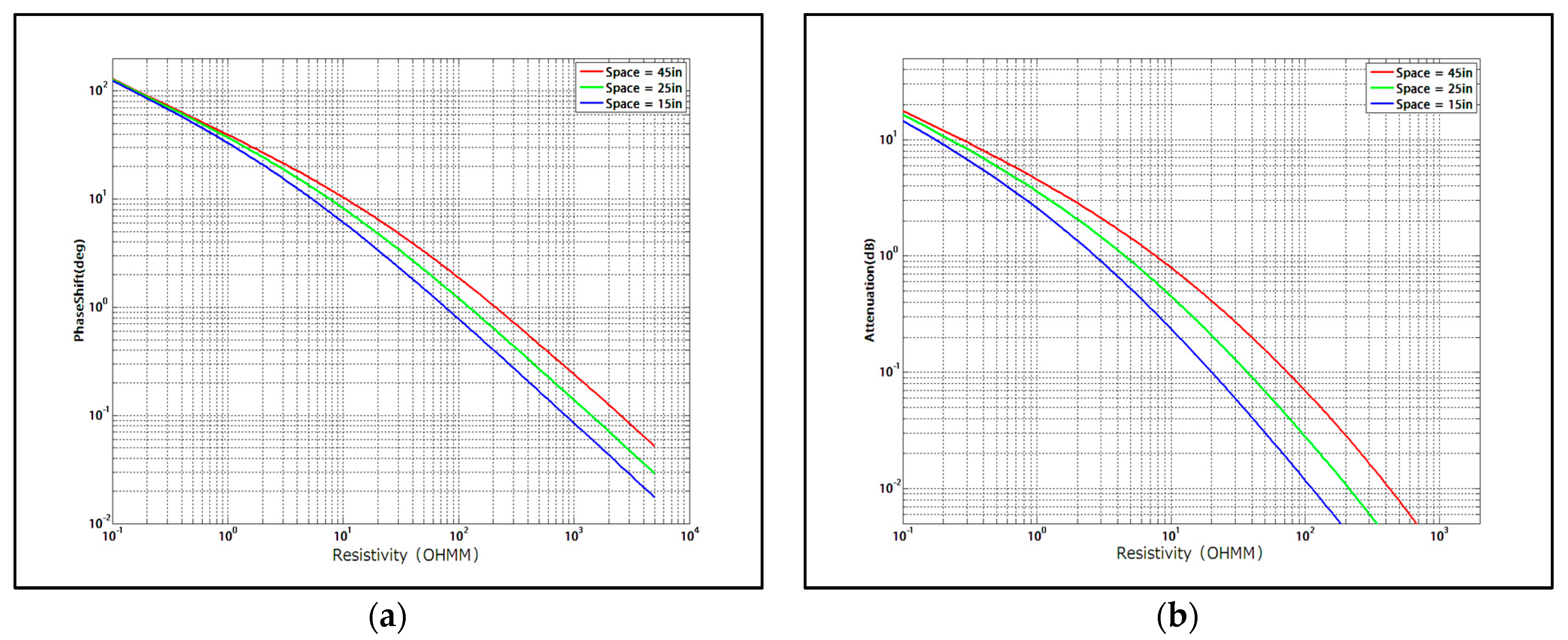

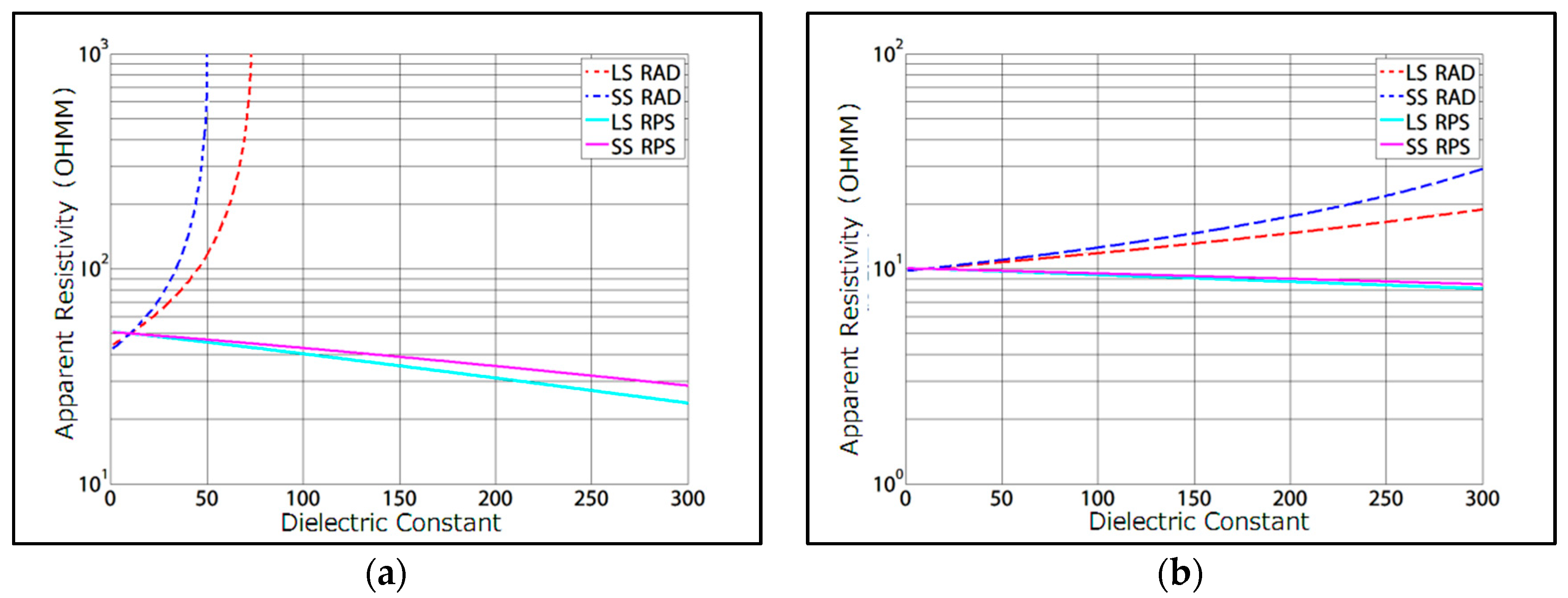
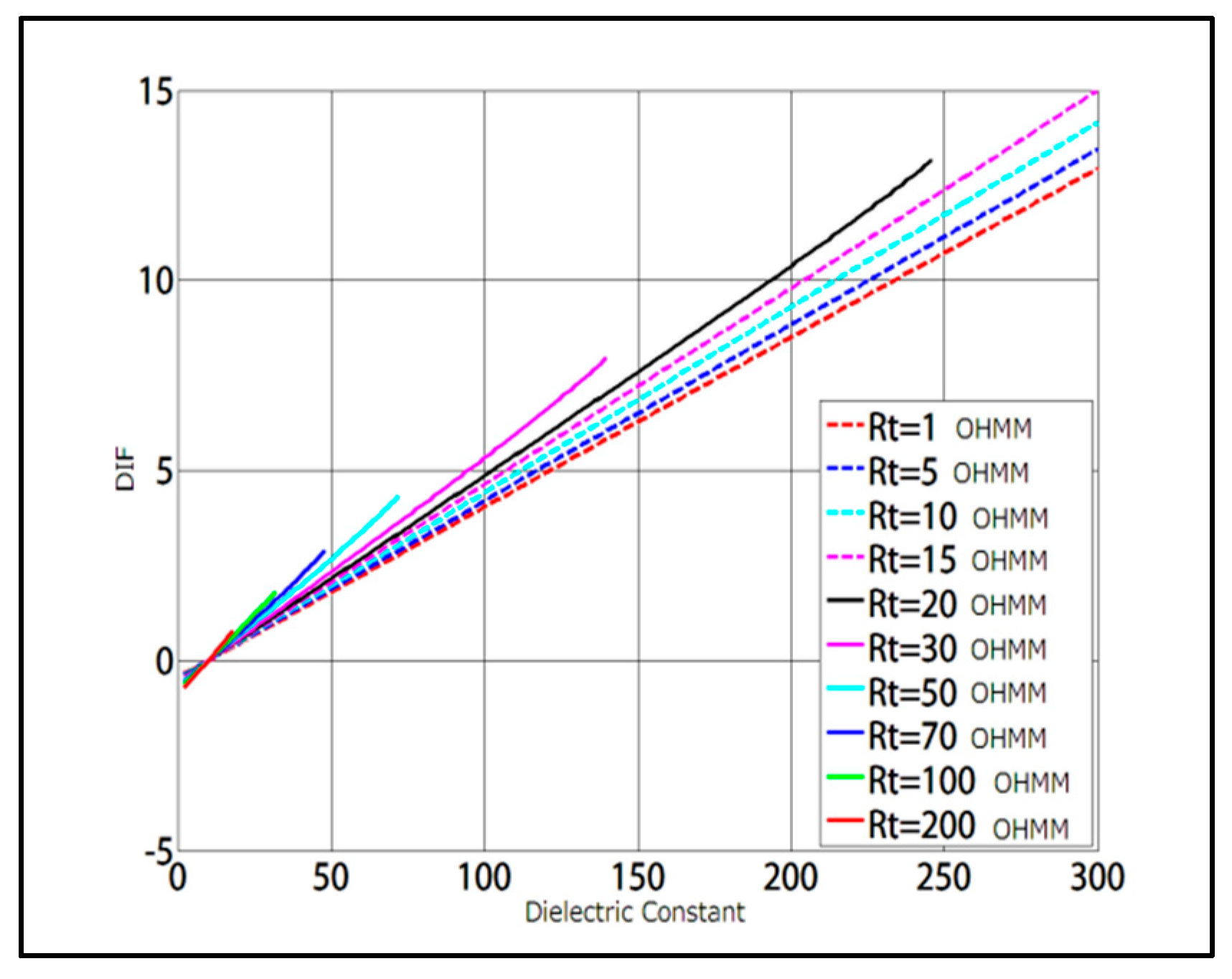
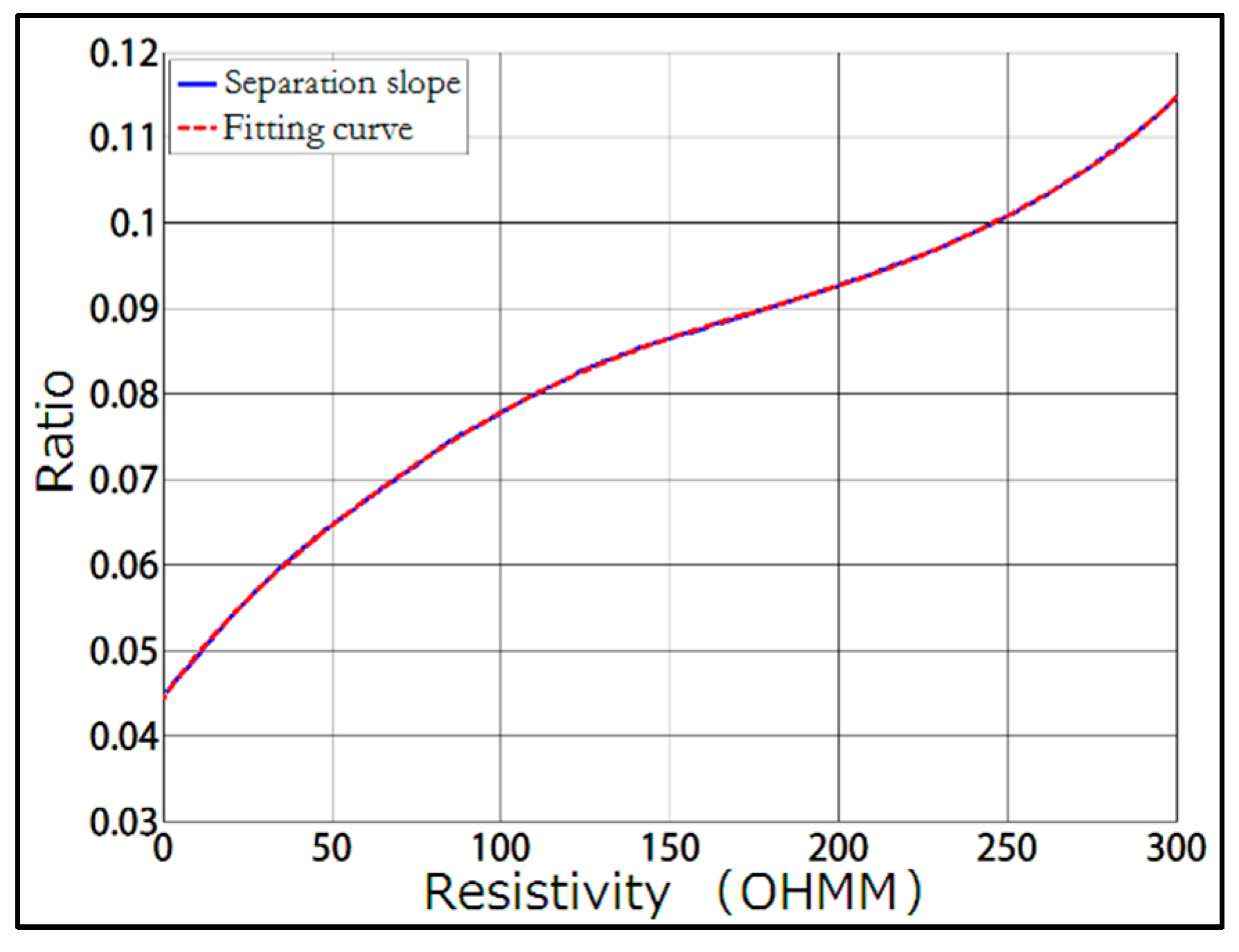
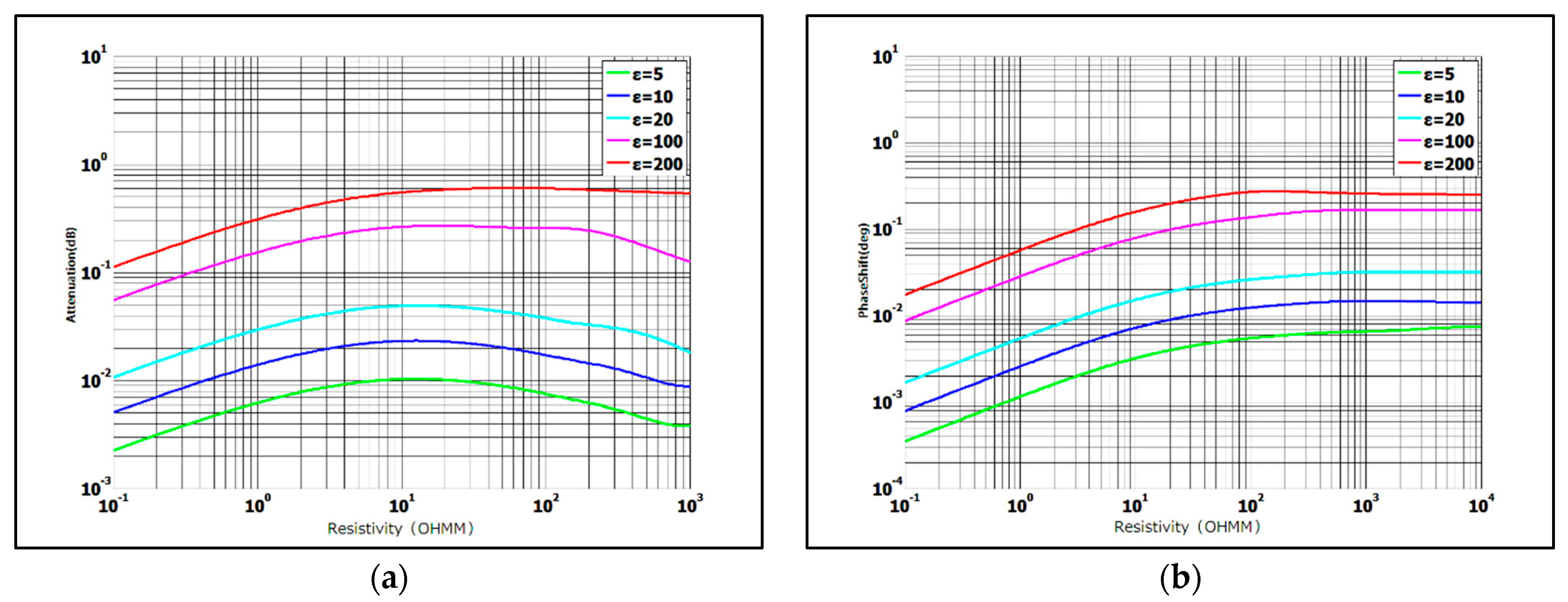

| Number | Top Depth (ft) | Bottom Depth (ft) | Resistivity (OHMM) | Number | Top Depth (ft) | Bottom Depth (ft) | Resistivity (OHMM) |
|---|---|---|---|---|---|---|---|
| 1 | 95 | 100 | 10 | 15 | 197 | 207 | 1500 |
| 2 | 100 | 117 | 100 | 16 | 207 | 211 | 190 |
| 3 | 117 | 125 | 4 | 17 | 211 | 216 | 5000 |
| 4 | 125 | 159 | 30 | 18 | 216 | 219 | 17 |
| 5 | 159 | 132 | 9 | 19 | 219 | 223 | 800 |
| 6 | 132 | 139 | 200 | 20 | 223 | 227 | 9 |
| 7 | 139 | 143 | 7 | 21 | 227 | 231 | 20 |
| 8 | 143 | 149 | 900 | 22 | 231 | 236 | 180 |
| 9 | 149 | 152 | 600 | 23 | 236 | 239 | 19 |
| 10 | 152 | 157 | 3300 | 24 | 239 | 241 | 200 |
| 11 | 157 | 164 | 400 | 25 | 241 | 243 | 70 |
| 12 | 164 | 182 | 1600 | 26 | 243 | 245 | 180 |
| 13 | 182 | 190 | 400 | 27 | 245 | 262 | 7 |
| 14 | 190 | 207 | 16 | 28 | 262 | 267 | 10 |
Disclaimer/Publisher’s Note: The statements, opinions and data contained in all publications are solely those of the individual author(s) and contributor(s) and not of MDPI and/or the editor(s). MDPI and/or the editor(s) disclaim responsibility for any injury to people or property resulting from any ideas, methods, instructions or products referred to in the content. |
© 2023 by the authors. Licensee MDPI, Basel, Switzerland. This article is an open access article distributed under the terms and conditions of the Creative Commons Attribution (CC BY) license (https://creativecommons.org/licenses/by/4.0/).
Share and Cite
Gao, C.; Wu, D.; Liu, J.; He, Q.; Deng, R. Expanding Measuring Range of LWD Resistivity Instrument in High Permittivity Layers. Processes 2023, 11, 1175. https://doi.org/10.3390/pr11041175
Gao C, Wu D, Liu J, He Q, Deng R. Expanding Measuring Range of LWD Resistivity Instrument in High Permittivity Layers. Processes. 2023; 11(4):1175. https://doi.org/10.3390/pr11041175
Chicago/Turabian StyleGao, Chengquan, Dong Wu, Jichun Liu, Quan He, and Rui Deng. 2023. "Expanding Measuring Range of LWD Resistivity Instrument in High Permittivity Layers" Processes 11, no. 4: 1175. https://doi.org/10.3390/pr11041175
APA StyleGao, C., Wu, D., Liu, J., He, Q., & Deng, R. (2023). Expanding Measuring Range of LWD Resistivity Instrument in High Permittivity Layers. Processes, 11(4), 1175. https://doi.org/10.3390/pr11041175









